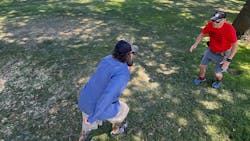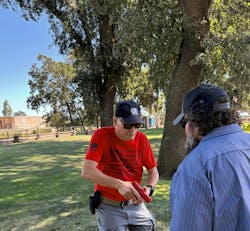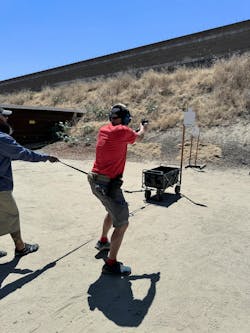The OODA Loop: Training to Reduce the Decision-Making Duration
What to Know
- The OODA Loop—Observe, Orient, Decide, Act—is a continual process that helps improve decision-making speed in conflict situations.
- Training should focus on reducing the decision time within each phase of the OODA Loop to get inside the opponent’s response cycle.
- Pre-positioning resources, such as ambulances or reserve forces, can significantly decrease reaction times during emergencies.
More on OFFICER.com
Download the September/October issue of OFFICER Magazine.
Click Here to subscribe to OFFICER Magazine.
I have been to several different training schools that have experimented with response time against a charging aggressor. All of them had different approaches to similar threats. When I began experimenting with the concept, I came to the same conclusion. There isn’t a perfect solution. There is a common approach. We have to train to reduce the decision-making duration of the OODA Loop.
The OODA Loop, a decision-making framework, stands for Observe, Orient, Decide, and Act. It was developed by USAF Col. John Boyd, who digested his observation of aerial combat in the Korean War. The OODA concept has been applied to many different activities, including corporate decision-making, asymmetric warfare, sporting events, and law enforcement.
Each phase of the acronym is important, and serves a specific purpose. One observes by gathering all data to form an accurate status of the current situation. They orient, using data analysis, to develop a comprehensive picture. Based on the Observation and Orientation, a course of action is planned/selected. During the Act phase, the chosen course of action is implemented.
It should be understood that OODA is a continual process, where the phases will have various sources, influences, and outcomes. Although we conceptualize it as a loop, users should not be so dogmatic to believe it flows directly from one thing to another. In fact, the idea is to “get inside your opponent’s loop.”
Boyd’s briefing “Patterns of Conflict,” originally presented in 1976, is considered one of the most influential and doctrine changing theories in modern warfare.
The premise of the Patterns of Conflict briefing is the introduction of the OODA loop, which explains the process of continual decision-making and response activity that happens in combat or conflict. Although it is called the OODA Loop, it shouldn’t be considered sequential in practice. Any dogmatic application of the OODA Loop is really self-defeating.
Each of these phases consume time. Time favors the opponent who runs through the OODA Loop most efficiently. We have to throw in other relevant factors also. For example, the warfare winner who makes correct and actionable decisions will prevail. The one whose action is most decisive will prevail.
The OODA Loop can be applied to individuals or entire units in conflict with a similar level of success. This is an important concept. I use the same principles in martial arts training by having both templated responses, which circumvent the decision process, and abbreviated techniques, which link the decide and act process faster.
Pre-positioning
Law enforcement officers can pre dispose decisions for faster response. For example, working with dispatch, I learned to pre-position an ambulance at strategic locations while en route to a hot call. Deploying an ambulance takes a series of decisions, such as whether to deploy, and where to request them. Pre-deploying reduces a step, a recommended practice, if available.
Globally, the OODA Loop is applied in many aspects of strategy. When I was in OCS (Officer Candidate School) in the military, some tactical experts taught us to position reserve forces in strategic locations that would allow rapid response without prematurely committing them. Police administrators do the same thing. When a mass event happens, they have to strategize to fill the next shift, and notify mutual aid.
Blauer Tactical
Police trainers worth knowing have created methods that speed the process in one way or another. For example, Coach Tony Blauer, who provides real world seminars for agencies, trains officers in using the startle-flinch response, a survival instinct when threatened, to their advantage. I’ve not been to one of his seminars, but I have followed him for years. His training helps students re-frame this primitive brain response, which circumvents the cognition steps in OODA, into action. I recommend law enforcement agencies consider hosting this training at [email protected].
Charging threat
The one puzzle that Law Enforcement has never resolved is the problem of a charging threat. Lt. Dennis Tueller, for whom the “21-Foot Rule” was named, theorized that a person could cover 21 feet in 1.5 seconds, the time it generally took a Law Enforcement Officer to draw and accurately fire their service firearm.
I should mention that I spoke to Lt. Tueller about this years ago (Officer Magazine December 2016). His thinking was far ahead of the times, and He told me the term “21-Foot Rule” was something someone coined. That is, someone else came up with a distance. Tueller was just communicating that we can’t underestimate a charging threat. 21 feet is definitely a danger zone, but this zone explains the threat within the Act phase. The Observe and Orient parts are not calculated here.
Even without the calculations, many have experimented with a charging threat response, including me. There are various factors, such as the fact that the Law Enforcement application of force can only be reactive. In the world of OODA, all a suspect has to do is successfully mask their intentions, and they are inside the Officer’s decision-making process.
When I used data to test the distance a suspect can cover before the Officer can counter, it was generally in the 30 to 32 foot range. I have to go back to the other thing Tueller told me years ago, “Don’t expect your first shot to turn off the attacker.”
What can we do? First, when it comes to a charging suspect, get off the X. Most trainers consistently teach that the correct action is to move, rather than stand still. We call this “getting off the X” in training lingo. The question we have to ask is, “move where?”
If the officer retreats in the direction the suspect is traveling, he is creating distance, but it just becomes a race. Few people can run backwards as quickly as one runs forward. This strategy may create distance, but it barely delays the inevitable.
Moving toward the charging suspect could be viable, but it cuts off both parties decision/response time. For a known threat, known weapon, it may work.
If the officer retreats in a pattern perpendicular or diagonally rearward to the line of attack, it creates distance from the X, but it allows the attacker to re-orient. The track of the assailant will be parabolic in relation to the two axis. The path of the attacker is almost shortened, in relation to the officer.
In the same manner we respond to an attack in martial arts, I recommend that officers move diagonally opposite the assailant’s travel. The suspect has to “track” and “re-orient” while moving.
I made the mistake of enlisting my friend Bobby Jones to experiment a little with this course of action. I forgot that he is a former offensive lineman. When I started experimenting with this at a walking pace, I noticed his automatic responses: He tracked my movement with a full head turn, which caused his body to accurately follow my movements. When we sped it up a little, he could almost overtake me, even when I moved diagonally.
Moving diagonally seemed to be the best direction, with regards to OODA.
This is a good life lesson, by the way. Some of the suspects we might encounter could be in top form. This is why we have tools like TASERs and firearms.
Training
Training for a charging target only requires a simple mechanism that moves the target toward the shooter. Most simple arrangements are broken lawn mowers with attached target stands. The mower or wagon is attached to a rope, and someone pulls the rope while a person is shooting.
It is a challenge to be on target while drawing and moving diagonally in relation to the line of attack. Pulling the rope at a walking pace can be humbling. Having the target come at you at a running pace is devastating.
The best I can give you is a recommendation. Get off the X and deliver a templated decisive response. The standard is to draw and deliver the first shot within 1.5 seconds. Know your capabilities, equipment, and standards in use of force. Train, train, train.
About the Author

Officer Lindsey Bertomen (ret.), Contributing Editor
Lindsey Bertomen is a retired police officer and retired military small arms trainer. He teaches criminal justice at Hartnell College in Salinas, California, where serves as a POST administrator and firearms instructor. He also teaches civilian firearms classes, enjoys fly fishing, martial arts, and mountain biking. His articles have appeared in print and online for over two decades.


